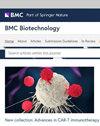包覆伞形酮的纳米铝 MOF 的合成与评估:在蚯蚓模型中评估抗氧化、抗炎和伤口愈合潜力
IF 3.5
3区 生物学
Q2 BIOTECHNOLOGY & APPLIED MICROBIOLOGY
引用次数: 0
摘要
通过溶热法合成了纳米多孔铝金属有机框架(Al-MOF),并将其作为载体基质用于茵贝酮(Um)的体外给药。以 pH 值为 7.4 的模拟体液磷酸盐缓冲盐水(PBS)为释放介质,在 37 °C、7 天内逐渐释放被包裹的 Um。药物释放曲线表明,Al-MOF 纳米粒子具有作为有效药物递送载体的潜力。利用傅立叶变换红外光谱(FTIR)、X 射线衍射仪(XRD)和紫外可见光谱(UV-Vis)对负载 Um 的 Al-MOF 纳米粒子(Um-Al MOF)进行了结构和化学分析。热重分析(TGA)用于研究 Al-MOF 纳米粒子的热稳定性,而透射电子显微镜(TEM)则用于评估其形态特征。与单独的 Um 和 Al-MOF 纳米粒子相比,Um-Al MOF 纳米粒子具有显著的抗氧化和抗炎特性。此外,它们还在蚯蚓模型中显示出明显的伤口愈合能力。这些发现凸显了 Al-MOF 纳米粒子作为一种前景广阔的给药系统的潜力,因此有必要对其进行进一步研究,以探索其临床适用性。本文章由计算机程序翻译,如有差异,请以英文原文为准。
Synthesis and evaluation of nanosized aluminum MOF encapsulating Umbelliferon: assessing antioxidant, anti-inflammatory, and wound healing potential in an earthworm model
Nanoporous aluminum metal–organic framework (Al-MOF) was synthesized via solvothermal methods and employed as a carrier matrix for in vitro drug delivery of Umbelliferon (Um). The encapsulated Um was gradually released over seven days at 37 °C, using simulated body fluid phosphate-buffered saline (PBS) at pH 7.4 as the release medium. The drug release profile suggests the potential of Al-MOF nanoparticles as effective drug delivery carriers. Structural and chemical analyses of Um-loaded Al-MOF nanoparticles (Um-Al MOF) were conducted using Fourier-transform infrared (FTIR) spectroscopy, X-ray diffractometry (XRD), and ultraviolet–visible (UV–Vis) spectroscopy. Thermal gravimetric analysis (TGA) was employed to investigate the thermal stability of the Al-MOF nanoparticles, while Transmission Electron Microscopy (TEM) was utilized to assess their morphological features. Um-Al MOF nanoparticles demonstrated notable antioxidant and anti-inflammatory properties compared to Um and Al-MOF nanoparticles individually. Moreover, they exhibited significant enhancement in wound healing in an earthworm model. These findings underscore the potential of Al-MOF nanoparticles as a promising drug delivery system, necessitating further investigations to explore their clinical applicability.
求助全文
通过发布文献求助,成功后即可免费获取论文全文。
去求助
来源期刊

BMC Biotechnology
工程技术-生物工程与应用微生物
CiteScore
6.60
自引率
0.00%
发文量
34
审稿时长
2 months
期刊介绍:
BMC Biotechnology is an open access, peer-reviewed journal that considers articles on the manipulation of biological macromolecules or organisms for use in experimental procedures, cellular and tissue engineering or in the pharmaceutical, agricultural biotechnology and allied industries.
 求助内容:
求助内容: 应助结果提醒方式:
应助结果提醒方式:


